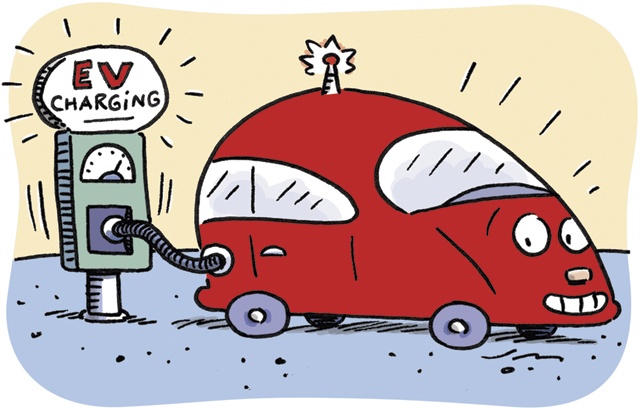In a crowded parking lot at Whole Foods Market’s flagship store in Austin, I whip into an empty spot marked “EV charging only,” feeling pretty smug. I’m testing a Toyota Prius plug-in hybrid—an EV, or electric vehicle—slated to hit the U.S. market in 2012.
I hop out and study the ChargePoint station. On a post about 5 feet high, an LED (light-emitting diode) display blinks above a metal panel. I charged the car at home last night, a process no more complicated than plugging in the coffeemaker, but the station has me flummoxed. I tug on the panel and stare at the display.
My daughter points out the toll-free number on the post. Ah. I call customer support and get a friendly, live voice asking for my name, phone number, location and e-mail. The e-mail, I am told, is for identification when I call back to end the charge. A few seconds later I hear a click, lift the panel and plug in the car. Then it’s off for a latte and some shopping.
About an hour later, we’re ready to go. The car isn’t fully charged—that would take another 30 minutes or so—but we call, open the panel, unplug and take off, with 7.5 miles of battery range. Fully charged, the car is capable of traveling 13 miles at a maximum highway speed of 60 mph solely on lithium-ion battery power (non-plug-in hybrids typically operate on electric power at 5 to 20 mph). That’s far enough for many commutes, including the short one from my Central Austin home to downtown.
Those with access to a charge station at work can drive 13 miles on battery power back home, as well. When the 13 miles of the electric charge run out, the Prius switches to hybrid mode, with the gasoline engine kicking in.
“It’s the best of both worlds,” says Jana Hartline, environmental communications manager for Toyota Motor Sales U.S.A., the company that lent me the car. The research, she says, is “tried and true Prius technology, which gets about 50 miles per gallon, with the added range of electric power.”
I charged the car overnight in my garage. Charging on a home’s standard 110-volt plug pulls 1 to 1.2 kilowatts per hour, Hartline says, roughly equivalent to running a hair dryer or window air conditioner. A full charge takes three hours on 110 volts. Hartline notes that plug-in hybrid owners with access to a 220-volt outlet—the same type used for household dryers and ranges—could cut the charging time in half.
“The average cost of [residential] electricity in the U.S. is about 11 cents per kilowatt-hour,” Hartline says. “The average cost to charge the Prius will run about 33 cents.”
Assuming that cost, an owner would pay $1.65 to charge a Prius plug-in hybrid five times a week.
The time certainly seems ripe for EVs. Under a ruling from the U.S. Department of Transportation and the Environmental Protection Agency, makers of new passenger cars and light trucks must improve fuel economy by 5 percent each year from 2012 to 2016, reducing tailpipe emissions of greenhouse gases by 5 percent at the same time (EVs have no tailpipe emissions).
As for other EVs, Nissan offers the Leaf, with a stated 100-mile-per-charge range, and the Chevy Volt pairs a 40-mile electric motor with a gas engine that turns an electricity-producing generator. An electric version of Honda’s Fit with a 100-mile claimed range is set to hit the market in 2012.
To service EV growth, a U.S. Department of Energy grant funded 4,600 charging stations nationwide, and Coulomb Technologies has installed roughly 100 across Texas. ChargePoint stations feature a communications network, which explains how I was able to call in and get the Whole Foods Market station opened. The network also allows drivers to find stations online and see which ones are available or in use. Users can even get a text or e-mail when their charging session is complete. Currently, many Texas stations are free to use.
I drove the plug-in around Austin for three days, and the gas gauge needle never budged from full. When I passed battery range, the car switched seamlessly to hybrid mode. I wouldn’t have even noticed except for the dashboard display. Living in Central Austin and working at home, my daily trips generally don’t go much beyond 13 miles. I could get used to this.
——————–
Melissa Gaskill is a frequent contributor to Texas Co-op Power.


